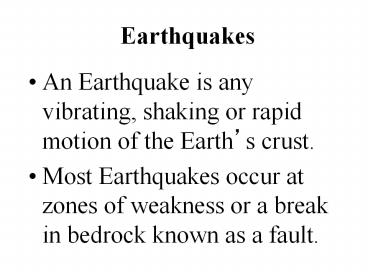Earthquakes - PowerPoint PPT Presentation
1 / 37
Title:
Earthquakes
Description:
Magnitude scales- based on seismometer ... Seismograph- a seismometer that makes a recording of seismic waves. Each magnitude is 10 times greater than the previous ... – PowerPoint PPT presentation
Number of Views:193
Avg rating:3.0/5.0
Title: Earthquakes
1
Earthquakes
- An Earthquake is any vibrating, shaking or rapid
motion of the Earths crust. - Most Earthquakes occur at zones of weakness or a
break in bedrock known as a fault.
2
Folding
3
Thrust
4
- When the stress built up in the rock is greater
than what the rock can resist, the crust shifts. - A sudden release of energy radiates in all
directions as vibrations.
5
Cute Baby Moment
6
- The focus is the place underground where the
actual break occurs. - The epicenter is the surface directly above the
focus.
7
Epicenter
focus
8
- After the earthquake waves move away from the
epicenter. - When the waves reach a location the earth seems
to shake. - The further a location is from the epicenter the
weaker the waves are when they reach that
location.
9
San Andreas Fault Video(45MIN)
https//www.youtube.com/watch?vb5f09mh-gIM
San Andreas Fault Video (4.5 min)
https//www.youtube.com/watch?v_YLjIvJXhpg
10
There are two kinds of waves
P S
11
P (primary waves)- travel through liquids and
solids. P waves move faster than S waves. P waves
cause particles to move in the direction of the
wave.
12
S (secondary waves)- travel only through
solids. S waves are slower than P waves. S waves
cause particles to move at right angles to the
direction of the wave.
13
L (Land) Waves are caused when P Waves and S
Waves Combine to cause a circular motion of the
rock particles. L waves cause the most
destruction during an Earthquake
14
Land Waves
15
- The characteristics waves have in different
conditions allows geologists to infer properties
of the Earths interior. - https//www.youtube.com/watch?vyOGoKCK17a4
16
Measuring Earthquakes
- There are two different ways to measure
earthquakes. - Magnitude scales- based on seismometer readings.
- Intensity scales- based on reports of damage.
17
(No Transcript)
18
(No Transcript)
19
- Magnitude Scales
- Seismometer- an instrument designed to detect and
measure seismic waves. A pen is attached to a
heavy mass on a spring. When the ground shakes,
the mass remains stationary and the paper moves
under it.
20
11 210 3100 41000 510000 5100000 71000000 8
10000000 9100000000 7 is 100X greater than a 5
21
(No Transcript)
22
(No Transcript)
23
- Seismograph- a seismometer that makes a recording
of seismic waves. - Each magnitude is 10 times greater than the
previous number. - A magnitude 5 earthquake is 10 times stronger
than a magnitude 4 earthquake. A magnitude 6 is
100 times stronger than a magnitude 4.
24
- Intensity scale-
- The Mercalli scale is based on the damage to
structures and accounts of witnesses. - 1-2 - may not be felt
- 5-6 - some dishes and windows break
- 7-8 - hard to stand, collapse of some structures.
- 10-11 - Visible waves on ground, total
destruction.
25
(No Transcript)
26
Since we know how fast P-waves and S-waves
travel, we can use this information to calculate
the distance to an epicenter
27
(No Transcript)
28
Damage from Earthquakes
- Shaking- buildings may be damaged or collapse.
- Movement of crust- damages roads and railroads.
- Tsunamis- earthquakes in oceans cause large waves
which may swamp coastal areas thousands of miles
away.
29
Human Dangers
- Fires- broken gas pipes often ignite.
- Broken water mains make it hard to fight fires.
- Landslides often occur in soft ground.
- Areas of high risk have stricter building codes
to help keep structures from falling apart during
quakes.
30
- Locations of Earthquakes and Volcanoes
- Most all earthquakes and volcanoes occur in a
belts of crustal activity. - The largest belt surrounds the Pacific ocean
which is an old ocean plate and is subducting all
around its borders. It is called the Ring of
Fire.
31
Damage from Volcanoes
- Ash- may cover large areas, very difficult to
deal with. Machines may not work, clogs air
filters. - Lava- smaller areas covered but nearly
unstoppable. - Toxic gasses- hot, fast-moving gasses may
suffocate people.
32
(No Transcript)
33
(No Transcript)
34
(No Transcript)
35
(No Transcript)
36
(No Transcript)
37
(No Transcript)































